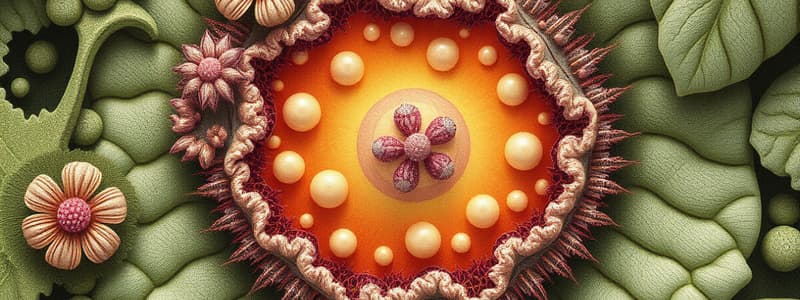Podcast
Questions and Answers
Which of the following are basic types of plant cells?
Which of the following are basic types of plant cells?
- Sclerenchyma (correct)
- Collenchyma (correct)
- Epidermis
- Parenchyma (correct)
What is the role of parenchyma cells?
What is the role of parenchyma cells?
They are metabolically active and can remain alive after maturity.
What distinguishes chlorenchyma cells?
What distinguishes chlorenchyma cells?
- They are dead at maturity.
- They are photosynthetic parenchyma cells. (correct)
- They are glandular cells.
- They transport water.
All parenchyma cells die at maturity.
All parenchyma cells die at maturity.
What are the two types of sclerenchyma?
What are the two types of sclerenchyma?
Collenchyma cells allow for __________ due to their thickened walls.
Collenchyma cells allow for __________ due to their thickened walls.
Sclerenchyma cells are usually alive at maturity.
Sclerenchyma cells are usually alive at maturity.
What do tracheary elements of the xylem do?
What do tracheary elements of the xylem do?
What substances do glandular cells secrete?
What substances do glandular cells secrete?
Flashcards are hidden until you start studying
Study Notes
Basic Types of Cells and Tissues
- Plant cells are categorized into three main types based on cell wall characteristics: parenchyma, collenchyma, and sclerenchyma.
Parenchyma
- Parenchyma cells have only thin primary walls and are metabolically active.
- Most parenchyma cells remain alive after maturation and can be specialized into types such as:
- Chlorenchyma: Photosynthetic, with thin walls that facilitate light and CO2 penetration.
- Glandular cells: Secrete substances like nectar, fragrances, mucilage, resins, and oils.
- Transfer cells: Specialized for short-distance transport, characterized by extensive plasma membranes and numerous molecular pumps.
- Phloem: A type of parenchyma tissue that conducts nutrients long distances; some cells die at maturity to create open spaces.
- Parenchyma cells are inexpensive to produce due to their thin walls, leading to a soft composition in most leaves.
Collenchyma
- Collenchyma cells feature thin primary walls with thickened areas, providing flexibility and support.
- Typically located beneath the epidermis and around vascular bundles, helping to support plant structures.
Sclerenchyma
- Sclerenchyma cells have both primary and thick secondary walls, which are often lignified and elastic, providing strength to the plant.
- Generally dead at maturity and classified into two types:
- Mechanical sclerenchyma:
- Fibers are long and flexible.
- Sclereids are short, cube-shaped, inflexible, and brittle.
- Conductive sclerenchyma: Primarily involved in water transport, including tracheary elements of the xylem.
- Mechanical sclerenchyma:
- Plasmodesmata-rich areas must remain free of the secondary wall, resulting in narrow pits known as pit-pairs.
Studying That Suits You
Use AI to generate personalized quizzes and flashcards to suit your learning preferences.



